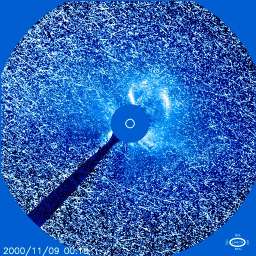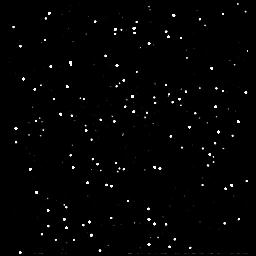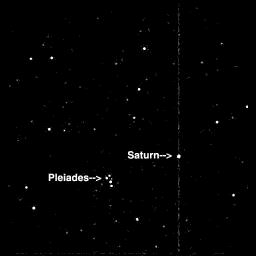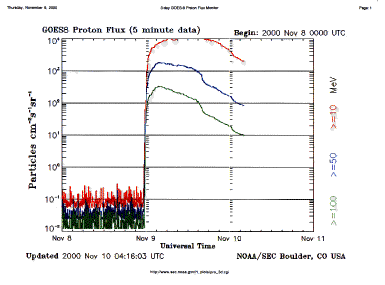| |||
|
|
|||
 | |||

STARDUST Spacecraft is "Temporarily Blinded" by Solar Flare
November 21, 2000
Between Wednesday evening and Thursday morning (9 - 10 November 2000), a powerful proton solar flare about ~100,000 times larger than normal hit the STARDUST spacecraft. Stardust was only 1.4 AU (130 million miles) from the Sun, and on its way back toward Earth for a gravity assist early next year. The solar wind's stream of high-energy protons impacted the spacecraft, and its two CCD area array star cameras. These proton hits to the CCD impart a charge to the pixels, producing star-like images. During a single star camera readout, hundreds of these star-like images inundated the star camera processor so that the star camera could not recognize its position in space.

A movie of the solar flare as observed by the SOHO spacecraft. Click on the above image to view the movie (1.1 MB) |
The star camera image processing uses the 12 brightest images to try to match their pattern to its star catalog. The 12 brightest images were not actually stars but proton hits. After many minutes of unsuccessful attempts to match star patterns using star camera A to maintain spacecraft's attitude control, the spacecraft entered safe mode. In safe mode, when the spacecraft stays in stand-by mode, the spacecraft tried again to determine its attitude in space from star camera A, but without success. Then the spacecraft swapped sides, and activated star camera B. But it had the same problem: of hundreds of bogus star-like images. It also failed to lock onto a certain star pattern. After a few more side swaps from side A to side B but still failing to achieve a lock on the stars, the spacecraft began rotating with its solar panels pointed toward the Sun and waited for the flight team to communicate with it.
The flight team, when confronted with the spacecraft not communication as planned on Thursday morning, understood that the solar flare most likely caused safe mode entry. They immediately began communications with the spacecraft. Telemetered fault history data substantiated the theory that the proton burst had caused outages in the star camera. The proton stream was diminishing over the next few days but still a represented threat. Therefore the spacecraft was left in its spin attitude state, keeping the solar panels pointed toward the Sun.
On Saturday 11 November, star camera A was reset and powered on. With the spacecraft attitude under IMU control, star images were processed and stellar acquisition was achieved with 5 star matches. The last star camera A image, taken on Thursday morning before spinning up the spacecraft in safe mode, was played back to Earth (Figure A). Hundreds of false star images can be seen in the picture - the brightest images were all proton hits, causing safe mode entry. Also, only the camera uses a circular area, 256 pixel in radius. The other outer pixels are masked to light. The protons penetrated even this masked area, giving star-like images in the CCD, thought it was never used for imaging.

Figure A: Last image taken before entering safe mode. Image shows hundreds of proton hits as solar flare occurred. |
The good image (Figure B) taken days after the solar flare subsided, shows many bright objects, all identified as stars or Saturn. The camera had completely recovered from the proton hits at this time.

Figure B: Image many days later with showing many stars and Saturn, and no proton hits. |
The safe mode entry causing failure to acquire signal during our scheduled pass on last Thursday morning is now well understood. The actions taken by the flight team, to immediately communicate with the spacecraft instead of waiting 24 hours for the spacecraft to communicate with Earth, were commendable. The team did a perfect job of predicting exactly what the environment was while the spacecraft was not in communications with Earth. All commanding decisions gave minimum risk to the spacecraft but with maximum return to the flight team!
On Monday, the STARDUST spacecraft was commanded to exit safe mode with the star camera A controlling the orientation. It has been working flawlessly. Additional fault and memory dumps were performed to ensure the entire spacecraft was free of proton events.

The solar flare as measured by the GOES 8 spacecraft. |
High praise must be given to the flight team at Lockheed Martin Astronautics (LMA) for their depth of expertise and knowledge of the STARDUST spacecraft operations. Their professionalism in working as a team within LMA and with JPL to quickly understand the spacecraft's state, and then take control of the situation within hours of knowing we had not acquired a signal was to be commended. Appreciation is also given to our fellow planetary missions who worked with us to obtain additional communication time if needed. By quickly understanding the cause of our problem and the state of our spacecraft, the STARDUST team was able to minimize its impact to other missions and their planned tracking.
The spacecraft performed as designed and recovered quickly after the proton stream subsided, demonstrating again the robustness of the spacecraft and flight team.


| Webmaster: Ron Baalke |
